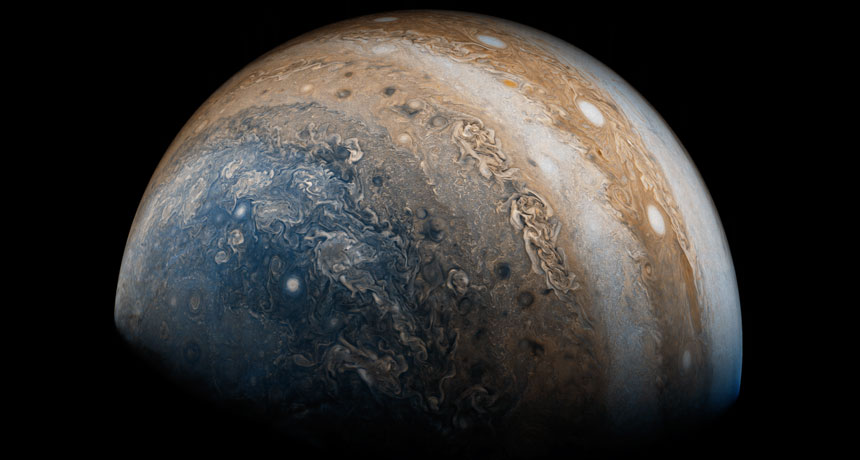Jupiter gets surprisingly complex new portrait
Juno flyby gives scientists first close-up of the giant planet

Data from NASA's Juno spacecraft are revealing new details of Jupiter, from swirling cyclones at the planet's poles (south pole, shown) to its great white ovals, storms and stripes of gas.
NASA, SWRI, MSSS
Scientists are repainting Jupiter’s portrait — scientifically, anyway. NASA’s Juno spacecraft swooped within 5,000 kilometers (3,100 miles) of Jupiter’s cloud tops last August 27. Scientists’ first close-up of the gas giant has unveiled several unexpected details about the planet’s gravity and powerful magnetic fields. They also give a new view of the planet’s auroras and ammonia-rich weather systems.
Researchers need to revamp their view of Jupiter, these findings suggest. They even challenge ideas about how solar systems form and evolve. The findings come from two papers published May 26 in Science.
“We went in with a preconceived notion of how Jupiter worked,” says Scott Bolton. “And I would say we have to eat some humble pie.” Bolton is a planetary scientist who leads the Juno mission. He works at the Southwest Research Institute in San Antonio, Texas.
Scientists thought that beneath its thick clouds, Jupiter would be uniform and boring. Not anymore. “Jupiter is much more complex deep down than anyone anticipated,” Bolton now observes.
One early surprise came from Jupiter’s gravity. Juno measured that gravity from its tug on the spacecraft. The values suggest that Jupiter doesn’t have a solid, compact core. Instead, the core is probably large and diffuse. It could even be as big as half the planet’s radius, Bolton and his colleagues conclude. “Nobody anticipated that,” Bolton notes.
Imke de Pater is a planetary scientist. She works at the University of California, Berkeley and was not involved in the new studies. The new gravity measurements should lead to a better understanding of the planet’s core, she says. But, she adds, doing so will require using some challenging math.
She was more surprised by Jupiter’s magnetic field. It is the strongest of any planet in our solar system. And Juno’s data show that it is almost twice as strong as expected in some spots. Its strength varies. It gets stronger than expected in some areas, weaker in others. These data support the idea that this magnetic field originates from circulating electric currents. Those currents are probably in one of the planet’s outer layers of hydrogen.
Responding to the ‘wind’
A second study looked at how Jupiter’s magnetic field interacts with a stream of charged particles flowing from the sun. Known as the solar wind, these particles affects Jupiter’s auroras, points out John Connerney. An astrophysicist, he led this study with colleagues at NASA’s Goddard Space Flight Center in Greenbelt, Md.
Auroras are brilliant shows of colored light that appear at or near a planet’s poles. (Earth’s auroras are known as the Northern and Southern Lights.) Juno captured Jupiter’s auroras in ultraviolet and infrared light. These images come from wavelengths beyond what the human eye can see. They showed particles falling into the planet’s atmosphere. That is similar to what happens on Earth. But they also showed beams of electrons shooting out from Jupiter’s atmosphere. Nothing like that occurs on Earth.
Bolton’s team described another oddity. Ammonia wells up from the depths of Jupiter’s atmosphere in a strange way. This upwelling resembles a feature on Earth called a Hadley cell. Warm air at our equator rises and creates trade winds, hurricanes and other forms of weather. Jupiter’s ammonia cycling looks similar to this. But Jupiter lacks a solid surface, the researchers note. So the upwelling likely works in a completely different way than on Earth. The scientists hope to figure out how this works on Jupiter. This could help scientists better understand the atmospheres of such huge gas planets.
Explains Bolton, Jupiter is a standard of comparison for all gas giants — both within and beyond our solar system. Most planetary systems have Jupiter-like planets. He says that means researchers can apply what they learn about Jupiter to giant planets elsewhere.







